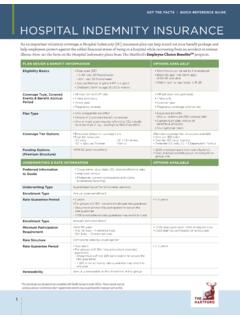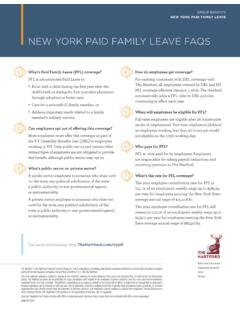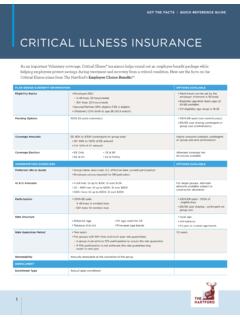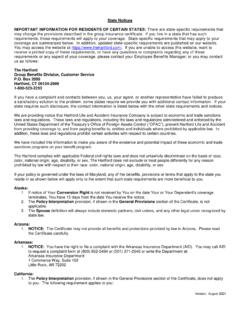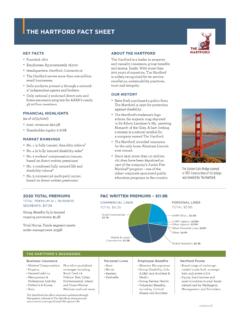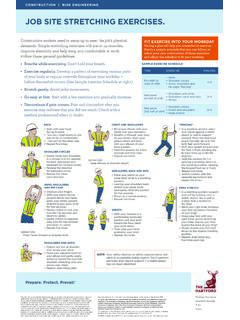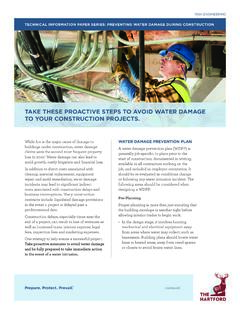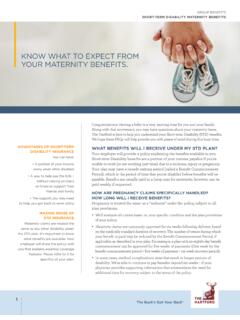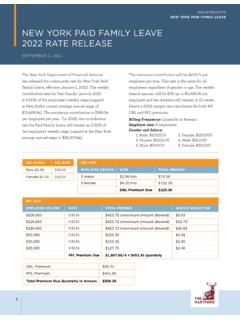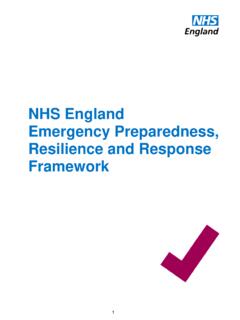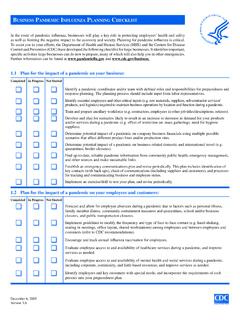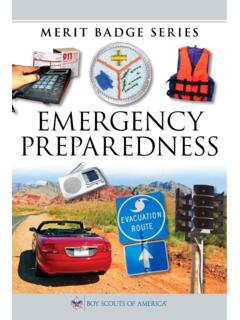Transcription of Emergency Preparedness in Construction
1 RISK ENGINEERINGTECHNICAL INFORMATION PAPER SERIES: Emergency Preparedness IN CONSTRUCTIONLEARN THE BASICS OF OSHA COMPLIANCE IN PLANNING FOR WORK SITE EMERGENCIES. continuedOn a Construction site, emergencies and disasters can strike anywhere, anytime causing potentially catastrophic injuries to workers and/or damage to property. That s why contractors should plan for workplace emergencies at all job sites to minimize employee injuries/illnesses and loss of property when an Emergency strikes. Types of emergencies can be a direct result of: Construction operations ( , occupational injury or illness) Indirect conditions ( , adverse weather conditions) A combination of bothImpact varies, too: Emergencies can affect one employee, area, or operation They can jeopardize an entire Construction project, community, or region What workplace emergencies defines a workplace Emergency to be: A situation that threatens workers, customers, or the public; disrupts or shuts down operations; or causes physical or environmental damage.
2 Emergencies may be natural or man-made, and may include hurricanes, tornadoes, earthquakes, floods, wildfires, winter weather, chemical spills or releases, disease outbreaks, releases of biological agents, explosions involving nuclear or radiological sources, and many other hazards. Emergencies may also include: Fire hazards Extended power loss Utility strikes Acts of terrorismPrepare. Protect. Prevail. 2 Preplanning is contractors understand the value of Emergency planning, but many lack the necessary level of preplanning and attention to detail needed for an effective contractor Emergency Preparedness plan. While contractors can never preplan for all potential workplace emergencies, having a sound plan with clearly defined roles and responsibilities can help minimize loss when an Emergency occurs. Preplanning also helps employers and workers anticipate other unpredictable situations.
3 First response : Life safety and safety is always the first priority. The actions taken in the initial minutes of an Emergency are critical: A prompt warning to employees to evacuate, shelter or lockdown can save lives. A call for help to public Emergency services that provides full and accurate information will help the dispatcher send the right responders and equipment. An employee trained to administer first aid or perform CPR can be lifesaving. Action by employees with knowledge of operations and process systems can help control a disaster and minimize property damage and/or environmental second priority is the stabilization of the incident and property conservation. There are many actions that can be taken to minimize potential damage: Use of fire extinguishers by trained employees can extinguish a small fire. Forecasting severe weather events hours before they arrive provides valuable time to protect a work site.
4 Establish a plan and have resources on hand, or quickly available, to prepare a site. The plan should also include a process for damage assessment, salvage, protection of undamaged property, and cleanup following an incident. These actions to minimize further damage and business disruption are good examples of property STANDARDSS everal OSHA standards address Emergency planning requirements, including: 29 CFR : Emergency Action Plans 29 CFR : Employee Emergency Action Plans 29 CFR (q): Hazardous Waste Operations and Emergency response (HAZWOPER) 29 CFR : Fire Brigades; and 29 CFR (k), 29 CFR : Permit-Required Confined Emergency Action versus Emergency workplace emergencies involving uncontrolled release of a hazardous substance, contractors must determine if their employees will be involved as responders or not.
5 TECHNICAL INFORMATION PAPER SERIES: Emergency Preparedness IN CONSTRUCTION31. If employees WILL be responders, an Emergency response plan is required. The contractor must comply with all provisions of OSHA Standard 29 CFR (q): Emergency response to hazardous substance releases (HAZWOPER), including the need to develop an Emergency response plan. Elements of an Emergency response plan, as outlined in (q)(2), include:1. Pre- Emergency planning and coordination with outside parties2. Personnel roles, lines of authority, training, and communication3. Emergency recognition and prevention4. Safe distances and places of refuge5. Site security and control6. Evacuation routes and procedures7. Decontamination8. Emergency medical treatment and first aid9. Emergency alerting and response procedures10. Critique of response and follow-up11.
6 PPE and Emergency equipmentOSHA considers to have broad coverage for Emergency response , applying to all employers who will have their employees respond to an uncontrolled release of a hazardous substance. Typical products found on Construction sites which may fall into this category include: Fuels Oils Waterproofing products Paints and related products, and Starting fluidsHowever, a small spill or leak of a hazardous substance would not necessarily constitute an Emergency or potential Emergency covered under this HAZWOPER If employees WON T be responders, an Emergency action plan (EAP) is Standard (q)(1) states: Employers who will evacuate their employees from the danger area when an Emergency occurs, and who do not permit any of their employees to assist in handling the Emergency , are exempt from the requirements of this paragraph if they provide an Emergency evacuation plan in accordance with of this part.
7 In this case, contractors are NOT required to have an Emergency response plan, but must have an Emergency action plan (EAP). This plan of action is used by the majority of contractors and other establishments that don t routinely handle extremely large quantities of hazardous materials. Even if your company isn t specifically required to do so, establishing an EAP is an effective method to adequately protect your employees and your business during an Emergency incident. An EAP that includes employee involvement during the planning process is usually the most effective. Although most companies don t anticipate an Emergency or disaster to occur at their site, the development of an EAP will help: Minimize confusion Protect employees Help prevent property damage in the event it does occurTECHNICAL INFORMATION PAPER SERIES: Emergency Preparedness IN CONSTRUCTIONEAP4 Assessing the workplace should be part of the best way to protect yourself and others is to prepare for an Emergency before it happens by doing a thorough assessment of the workplace.
8 Consider all potential emergencies that can be reasonably expected in the workplace and evaluate each site to see if it s sufficiently prepared. The Emergency action plan (EAP) should address: Types and locations of hazardous materials (refer to Safety Data Sheets) Potentially dangerous operations or conditions Chemical storage sites Remote job sites Workplace communication systems Employee work shifts Means of egress Evacuation routes and means to maintain routes in all ground and weather conditions Fixed and portable fire extinguishing systems Employee alarm systems Protection of visitors and members of the public Adverse weather conditionsWith more than 10 employees, a written plan is written plan is more effective, since it documents workplace evacuation procedures and allows employees to easily review previous communications.
9 In fact, OSHA Standard (e)(3) requires a written plan for employers with greater than 10 employees: The employer shall review with each employee upon initial assignment those parts of the plan which the employee must know to protect the employee in the event of an Emergency . The written plan shall be kept at the workplace and made available for employee review. For those employers with 10 or fewer employees the plan may be communicated orally to employees and the employer need not maintain a written plan. Contractors can establish one generic EAP with addendums for each location to clarify site-specific conditions and procedures to follow. The EAP should be reviewed during employee orientation meetings and refresher training programs, such as toolbox ACTION PLAN ELEMENTSA ccording to OSHA Standard , an Emergency action plan must include, at a minimum, the following elements:1.
10 Emergency escape procedures and Emergency escape route assignments:Evacuation policies, procedures and escape route assignments are put into place so that employees understand: Who s authorized to order an evacuation Under what conditions an evacuation would be necessary How to evacuate What routes to takeTECHNICAL INFORMATION PAPER SERIES: Emergency Preparedness IN CONSTRUCTION5 Preplanned maps and site floor is necessary to determine escape routes from each area of the site to a designated safe location(s) or refuge area(s). Designate both primary and secondary escape routes from each work area. The safe refuge area(s), commonly referred to as muster point(s) should be a designated location or locations at least 50 - 100 feet from the main work area or site entrance. The use of site floor plans or site maps that clearly show the escape routes and refuge area(s) should be included in the plan.
